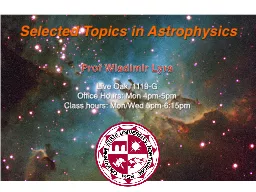

Prof Wladimir Lyra Live Oak 1119G Office Hours Mon 4pm5pm Class hours MonWed 5pm615pm Evolution of high mass stars The evolution we covered in last class is for low mass stars M lt 4 M ID: 780991
Download The PPT/PDF document "Selected Topics in Astrophysics" is the property of its rightful owner. Permission is granted to download and print the materials on this web site for personal, non-commercial use only, and to display it on your personal computer provided you do not modify the materials and that you retain all copyright notices contained in the materials. By downloading content from our website, you accept the terms of this agreement.
Slide1
Selected Topics in Astrophysics
Prof Wladimir
LyraLive Oak, 1119-GOffice Hours: Mon 4pm-5pmClass hours: Mon/Wed 5pm-6:15pm
Slide2Evolution of high mass stars
The evolution we covered in last class is for low mass stars (
M < 4 M
⊙
)
High mass stars differ basically due to the temperature of the core.
Slide3Evolution of high mass stars (
4 < M/M
⊙
< 8)
The Helium Flash never happens
The star reaches Helium burning temperatures
before
the core becomes degenerate
They also reach temperatures hot enough to burn Carbon600 million K Leaves a O-Ne-(Mg) white dwarf.
Slide4Evolution of high mass stars
M > 8 M
⊙
Carbon →
O,Ne,Mg
(600 million K)
Neon → O, Mg (1.5 Billion K)
Oxygen
→ Si, S, P (2.1 Billion K)
Silicon → Fe, Ni (3.5 Billion K)
Slide5The Sun’s abundance pattern
Because of the alpha ladder, elements
with even atomic number are more abundant than those with odd
Elements are made by Helium (alpha) capture.
Expected, since Iron is the end of the fusion sequence.
Slide6Evolution of high mass stars
M > 8 M
⊙
TIMESCALES FOR NUCLEAR BURNING
Hydrogen – 10 Myr
Helium – 1 Myr
Carbon – 1000 yr
Neon ~ 10 yr
Oxygen ~ 1 yr
Silicon ~ 1 day
Slide7Evolution of high mass stars
M > 8 M
⊙
The star develops an
“onion layers structure”
of burning shells
Carbon →
O,Ne,Mg
(600 million K)
Neon → O, Mg (1.5 Billion K)
Oxygen
→ Si, S, P (2.1 Billion K)
Silicon
→ Fe, Ni (3.5 Billion K)
But
Iron
is a
DEAD END
!!
Slide8Iron is a dead end
Iron is the most tightly bound element
Fusion beyond Iron TAKES energy
Fusion takes energy.
No fusion reactions left to yield energy!!
Slide9Core collapse
At
densities of 10
1 0
g/cm
3(remember: nuclear densities are ~101 4 g/cm3)Neutronization
Proton + electron
→
neutron + neutrino
(p + e- → n + n)
Electrons lost: electron degeneracy pressure is gone
Slide10Catastrophic collapse
6000 km
10
1 0
g/cm
3
Collapse speed: 0.25c
10 km
10
1 4 g/cm3
A second later
Nuclear densities!
Neutron degeneracy
provides
support against gravity
Slide11Slide12Core Bounce
The inner core stabilizes
and stops collapsing.
The core overshoots the
equilibrium radius
and
bounces.
Pressure wave hits
infalling
gas
The kinetic energy
that was directed
inwards is redirected
outwards
Iron core
collapses
Neutronization
Slide13The Thermonuclear Shock Wave
Infalling
gas meeting the
rebouncing
core generates a
shock waveThe blastwave generates explosive nuclear reactions along its path
Violently heats and accelerates the stellar envelope
Slide14Supernova!
In a few hours, the shockwave reaches the surface
From the outside, the star is seen to explode.
Slide15Supernova 1987A
Confirmation of the theory
A
burst of neutrinos
4 hours before the event
The progenitor had a mass of
20
M
⊙
.
Slide16Alpha ladder
Low mass stars produce elements up to Carbon and Oxygen
High mass stars produce all the rest of the periodic table
Up to Iron we have basically alpha reactions
Slide17Neutron capture
Beyond the Iron peak,
nucleosynthesis
occur by neutron capture and beta decay
(n
→ p + e- + n) The process is classified according to the neutron flux
S-process
(slow neutron capture)
Neutron capture occurs
slower than beta decayWorks up to bismuth (Z=83)Where?AGB stars + Supernovae
R-process
(rapid neutron capture)
Neutron capture occurs
faster
than beta decay
Really heavy stuff
All the way to Uranium
Where?
Supernovae
Slide18Neutron capture
Beyond the Iron peak,
nucleosynthesis
occurs by
neutron capture
and beta decay(n → p + e-
+
n
)
Neutron capture produces isotopes
Neutron capture proceeds until the nuclide goes unstable (radioactive)
If a proton decays, the atomic number decreases
But if a neutron decays, the atomic number increases!
Slide19Climbing the periodic table
Proton decays
Neutron decays
Slide20Ta-dah!
Slide21Nucleosynthesis
summary
Element
# of Protons
Site
H
1
Big Bang
He, C, O
2,6,8
Big Bang + Low and High Mass stars
Ne - Fe
10-26
High mass stars
Co - Bi
27-83
S and R process,
AGB
and SN
Po - U
84-92
R process in SN